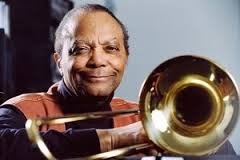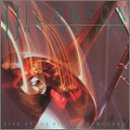Coppin' The Bop – J.J. Johnson
A fun stop-time workout, full of solo breaks in the head. Solos are on “rhythm changes,” with a second stop-time chorus used for J.J.’s solo on the recording. Condensed Score and parts are available for the quintet arrangement.
- Recording: J.J. Johnson - Quintergy
- Recorded on: July 9-10, 1988
- Label: Antilles (422-848214)
- Concert Key: B-flat
- Vocal Range: , to
- Style: Swing (medium)
- Trombone - J.J. Johnson
- Tenor Sax - Ralph Moore
- Piano - Stanley Cowell
- Bass - Rufus Reid
- Drums - Victor Lewis
- Description
- Historical Notes
- Solos
- Piano Corner
- Bass Corner
- Drum Corner
- Guitar Corner
- Inside & Beyond
- Minus You
Fun with stop-time! Coppin’ The Bop has a call-and-response format: a lopsided rhythmic figure, played by the entire ensemble, is alternated with solo breaks from different instruments. This is really a quintet arrangement, so we have a Condensed Score and parts instead of lead sheets; if you want to play this in a quartet setting, the horn player should read the condensed score and play all the breaks. The two horns trade breaks in the two A sections; the piano solos at B (a “rhythm changes” bridge) with 4-feel in the bass and drums, and C has a bass break and a drum break leading into the solos. Most of these breaks are written, but the tenor sax goes crazy (J.J.’s original manuscript says “go crazy”!) in measures 3 and 4 of the second A. The bass break at C is a variation of the tenor break in the first A. In the coda, the drum break is replaced with a trombone break, with the same melody as at the end of the A sections and joined by the other instruments in unison for the last measure.
Solos are on “rhythm changes.” For the first chorus of the trombone solo there is another stop-time chorus of rhythm section hits, included in our lead sheets and parts. The bridge (F) of this chorus goes back to 4-feel, and the last eight measures (G) are one long break for the soloist going into the next solo chorus.
First and second horn parts, piano, and bass parts are available. Drummers should read the Condensed Score. On the repeated-note rhythmic figures, the horns alternate between harmony in fourths and in half steps.
Solos are on “rhythm changes.” For the first chorus of the trombone solo there is another stop-time chorus of rhythm section hits, included in our lead sheets and parts. The bridge (F) of this chorus goes back to 4-feel, and the last eight measures (G) are one long break for the soloist going into the next solo chorus.
First and second horn parts, piano, and bass parts are available. Drummers should read the Condensed Score. On the repeated-note rhythmic figures, the horns alternate between harmony in fourths and in half steps.
Coppin’ The Bop was first recorded at J.J. Johnson’s debut session as a leader, on June 26, 1946 - which also happens to be the birth date of Don Sickler’s wife, Maureen Sickler. This original recording, which features Cecil Payne on alto sax (his first recording), Bud Powell on piano, Leonard Gaskin on bass and Max Roach on drums, is faster with a different arrangement. There is an eight-measure intro, no stop-time, and a melody added on the bridge.
Also check out the video (above) of J.J. playing this song in 1991, with a quintet including master jazz educator Jamey Aebersold on tenor sax. This version is close to the "Quintergy" arrangement, but with the horns voiced in half steps on all the rhythmic figures.
Also check out the video (above) of J.J. playing this song in 1991, with a quintet including master jazz educator Jamey Aebersold on tenor sax. This version is close to the "Quintergy" arrangement, but with the horns voiced in half steps on all the rhythmic figures.
Related Songs
Email Send Coppin' The Bop to a friend
Send this page to a friend via email. Add your name or email in the first field. In the second, add one or more email addresses, separated by a comma.

J.J. Johnson
January 22, 1924 – February 4, 2001
J.J. Johnson is arguably the most influential bop and post-swing trombonist and also one of the great composers and arrangers in jazz. He was one of the first trombonists to embrace bebop; his playing continues to exert a strong influence on other musicians. He started his recording career in 1942 in Benny Carter's big band. On July 2, 1944, J.J was on the first Jazz At The Philharmonic concert. He recorded with the Count Basie Orchestra beginning in 1945. Read more...
There was a problem.
...



